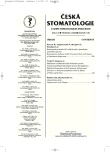-
Medical journals
- Career
Asymmetric Extraction as an Intergal Part of the Therapy by Solid Orthodontic Apparatus
Authors: P. Černochová
Authors‘ workplace: Stomatologická klinika LF MU a FN u sv. Anny, Brno
Published in: Česká stomatologie / Praktické zubní lékařství, ročník 108, 2008, 6, s. 73-78
Category:
Overview
Objective:
The aim of the present study was to analyze the frequency of individual types of extraction orthodontic therapy and to show indications and execution of asymmetric extractions.Material and Methods:
The authors performed a retrospective study of patients treated with a fixed orthodontic appliance in the period of 2001 through May 2008. The examined cohort included 475 patients – 316 women and the age of 9 to 48 years (mead age 16.2 years) and 159 men at the age of 9 to 35 years (mean age 14.92 years). From the available documentation and the results of examination the authors recorded diagnostic data of the patients and the orthodontic treatment. In the extraction method the type of the extracted tooth was analyzed. Indications and execution of asymmetric extractions is documented by the case reports.Results:
Extractions of permanent teeth were performed in 123 patients (25.89%). In 39 patients (8.21%) there were symmetric extractions from one jaw, in 24 patients (5.05%) there were symmetric extraction in both jaws, 50 other patients (10.52%) had asymmetric extractions in one booth arch and asymmetric extraction in both jaws were indicated in 10 patients (2.1%)Conclusion:
In one fourth of the orthodontic patients the extraction of a permanent tooth is the necessary component of orthodontic treatment. In half of the extraction cases there are symmetric extractions and in the other half there are asymmetric extractions of teeth in one or both jaws. A correct indication of asymmetric extractions and a precise performance of the subsequent orthodontic therapy employing a segmental technique, results in aesthetic, functional and stable results.Key words:
tooth extraction - asymmetric extraction - orthodontic treatment - fixed orthodontic appliance
Sources
1. Lindauer, S. J.: Orthodontic treatment planning. In Nanda, R.: Biomechanics in clinical orthodontics. W. B.Saunders Philadelphia, 1996, s. 23-49.
2. Nanda, R., Kuhlberg, A., Uribe, F.: Biomechanics basis of extraction space closure. In Nanda, R.: Biomechanics and esthetic strategies in clinical orthodontics. Elsevier Saunders Philadelphia, 2005, s. 194-210.
3. Proffit, W. R., Fields, H. W., Sarver, D. M.: Orthodontic treatment planning: limitations, controversies, and special problems. In Proffit, W. R., Fields, H. W. Jr., Sarver, D. M.: Contemporary orthodontics. Fourth edition. Mosby Elsevier, 2007, s. 268-327.
4. Rebellato, J.: Asymmetric extractions used in the treatment of patients with asymmetries. Semin. Orthod., roč. 4, 1998, č. 3, s. 180-188.
5. Tayer, B H.: The asymmetric extraction decision. Angle Orthod., roč. 62, 1992, č. 4, s. 291-297.
6. Uribe, F., Nanda, R.: Biomechanic strategies for optimal finishing. In Nanda, R.: Biomechanics and esthetic strategies in clinical orthodontics. Elsevier Saunders Philadelphia, 2005, s. 330-347.
7. Zachrisson, B. U.: Esthetics in tooth display and smile design. In Nanda, R.: Biomechanics and esthetic strategies in clinical orthodontics. Elsevier Saunders Philadelphia, 2005, s. 110-130.
Labels
Maxillofacial surgery Orthodontics Dental medicine
Article was published inCzech Dental Journal

2008 Issue 6-
All articles in this issue
- Retrospective Analysis of 447 Permanent Teeth with Injury of Attachment Apparatus
- Objective Evaluation of the Treatment of Functional Disorders in Temporomandibular Joint by Means of Photo-registration
- Liposarcoma of the Tongue
- Asymmetric Extraction as an Intergal Part of the Therapy by Solid Orthodontic Apparatus
- Etiology of Mandibular Fractures in Moravian - Silesian Region
- Czech Dental Journal
- Journal archive
- Current issue
- Online only
- About the journal
Most read in this issue- Liposarcoma of the Tongue
- Objective Evaluation of the Treatment of Functional Disorders in Temporomandibular Joint by Means of Photo-registration
- Asymmetric Extraction as an Intergal Part of the Therapy by Solid Orthodontic Apparatus
- Etiology of Mandibular Fractures in Moravian - Silesian Region
Login#ADS_BOTTOM_SCRIPTS#Forgotten passwordEnter the email address that you registered with. We will send you instructions on how to set a new password.
- Career

